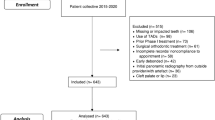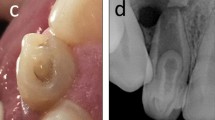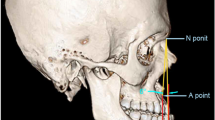Abstract
Objective
The aim of this study is to determine the age-based prevalence of dens invaginatus cases and to learn the radiologic findings. In addition, fractal analysis of the periapical regions of unilateral dens invaginatus cases and contralateral teeth was performed to determine the effect of possible microleakage on fractal dimension.
Methods
A total of 136 patients (170 teeth) identified in panoramic radiographs taken for diagnostic purposes between January 2018 and December 2023 at our Department of Oral and Maxillofacial Radiology were included in the study. Data were analysed using IBM SPSS V23. The Chi-square test was used for comparing categorical variables between groups. The relationship between the FD values calculated around the apexes of the teeth with unilateral dens invaginatus and the contralateral teeth was analyzed by paired t test. A significance level of p < 0.050 was adopted.
Results
The mean age of the cases was calculated as 28.1 (8–63) years. 66 (48.5%) of the cases were female, and 70 (51.1%) were male. The lateral incisor was the most affected tooth among these cases. Bilateral cases were observed in 34 patients. Type 2 was detected in 93 patients, Type 1 in 35 patients, and Type 3 dens invagination in 8 patients. Dens invaginatus cases were observed in 134 maxillary and 2 mandibular teeth. Periapical lesions were seen in 22 of these cases.
Conclusions
Dens invaginatus cases are a congenital anomaly encountered at any age. Early diagnosis is crucial to prevent the loss of pulp vitality due to these invaginations. It should be noted that these invaginations can affect both jaws. However, due to the prevalence of occurrence in the maxillary anterior teeth and asymptomatic nonvitality, particular attention should be paid to evaluating this region. Powered by.


Similar content being viewed by others
Data availability
Data will be shared upon reasonable request from the corresponding author.
References
Capar ID, Ertas H, Arslan H, Tarim EE. A retrospective comparative study of cone-beam computed tomography versus rendered panoramic images in identifying the presence, types, and characteristics of dens invaginatus in a Turkish population. J Endod. 2015;41:473–8. https://doi.org/10.1016/j.joen.2014.12.001.
Chen L, Li Y, Wang H. Investigation of dens invaginatus in a Chinese subpopulation using cone-beam computed tomography. Oral Dis. 2021;27:1755–60. https://doi.org/10.1111/odi.13702.
Alkadi M, Almohareb R, Mansour S, Mehanny M, Alsadhan R. Assessment of dens invaginatus and its characteristics in maxillary anterior teeth using cone-beam computed tomography. Sci Rep. 2021;11:19727. https://doi.org/10.1038/s41598-021-99258-0.
Varun K, Arora M, Pubreja L, Juneja R, Middha M. Prevalence of dens invaginatus and palatogingival groove in North India: a cone-beam computed tomography-based study. J Conserv Dent. 2022;25:306–10. https://doi.org/10.4103/jcd.jcd_46_22.
Kirzioglu Z, Ceyhan D. The prevalence of anterior teeth with dens invaginatus in the western Mediterranean region of Turkey. Int Endod J. 2009;42:727–34. https://doi.org/10.1111/j.1365-2591.2009.01579.x.
Siqueira JF, Roças IN Jr, Hernandez SR, Brisson-Suarez K, Baasch AC, Perez AR, Alves FRF. Dens invaginatus: clinical implications and antimicrobial endodontic treatment considerations. J Endod. 2022;48:161–70. https://doi.org/10.1016/j.joen.2021.11.014.
Zhu J, Wang X, Fang Y, Von den Hoff JW, Meng L. An update on the diagnosis and treatment of dens invaginatus. Aust Dent J. 2017;62:261–75. https://doi.org/10.1111/adj.12513.
Nosrat A, Schneider SC. Endodontic management of a maxillary lateral incisor with 4 root canals and a dens invaginatus tract. Int Endod J. 2015;41:1167–71. https://doi.org/10.1016/j.joen.2015.02.013.
Hegde V, Mujawar A, Shanmugasundaram S, Sidhu P, Narasimhan S, Setzer FC, Nagendrababu V. Prevalence of dens invaginatus and its association with periapical lesions in a Western Indian population-a study using cone-beam computed tomography. Clin Oral Invest. 2022;26:5875–83. https://doi.org/10.1007/s00784-022-04545-3.
Oehlers FA. Dens invaginatus (dilated composite Odontome). I. variations of the invagination process and associated anterior crown forms. Oral Surg Oral Med Oral Pathol. 1957;10:1204–18.
Tsiklakis K, Mitsea A, Tsichlaki A, Pandis N. A systematic re-view of relative indications and contra- indications for prescrib-ing panoramic radiographs in dental paediatric patients. Eur Arch Paediatr Dent. 2020;21:387–406.
Molander B, Ahlqwist M, Gröndahl HG. Panoramic and restric-tive intraoral radiography in comprehensive oral radiographic diagnosis. Eur J Oral Sci. 1995;103:191–8.
Kato CN, Barra SG, Pereira MJ, Gomes LT, Amaral TM, Abreu LG, et al. Mandibular radiomorphometric parameters of women with cemento-osseous dysplasia. Dentomaxillofac Radiol. 2020;49(4):20190359.
White SC, Rudolph DJ. Alterations of the trabecular pattern of the jaws in patients with osteoporosis. Oral Surg Oral Med Oral Pathol Oral Radiol Endod. 1999;88:628–35.
Alani A, Bishop K. Dens invaginatus. Part 1: classification, prevalence and aetiology. Int Endod J. 2008;41:1123–36.
Cakici F, Celikoglu M, Arslan H, Topcuoglu HS, Erdogan AS. Assessment of the prevalence and characteristics of dens invaginatus in a sample of Turkish Anatolian population. Med Oral Patol Oral Cir Bucal. 2010;15:855–8.
Gunduz K, Celenk P, Canger EM, Zengin Z, Summer P. A retrospective study of the prevalence and characteristics of dens invaginatus in a sample of the Turkish population. Med Oral Patol Oral Cir Bucal. 2013;18:27–32.
George R, Moule AJ, Walsh LJ. A rare case of dens invaginatus in a mandibular canine. Aust Endod J. 2010;36:83–6.
Ceyhanli KT, Buyuk SK, Sekerci AE, Karatas M, Celikoglu M, Benkli YA. Investigation of dens invaginatus in a Turkish subpopulation using cone-beam computed tomography. Oral Health Dent Manag. 2015;14:81–4.
Ireland EJ, Black JP, Scures CC. Short roots, taurodontia and multiple dens invaginatus. J Pediatr Dent. 1987;11:164–75.
Tavano SM, de Sousa SM, Bramante CM. Dens invaginatus in first mandibular premolar. Endod Dent Traumatol. 1994;10:27–9.
Gumussoy I, Miloglu O, Cankaya E, Bayrakdar IS. Fractal properties of the trabecular pattern of the mandible in chronic renal failure. Dentomaxillofac Radiol. 2016;45:20150389.
Günaçar DN, Yemenoğlu H, Ustaoğlu G, Arıöz Ö. Efects of hyperlipidemia on trabecular and cortical structures of the mandible. Dentomaxillofac Radiol. 2022;51(2):20210214.
Bayrak S, Goller Bulut D, Orhan K, et al. Evaluation of osseous changes in dental panoramic radiography of thalassemia patients using mandibular indexes and fractal size analysis. Oral Radiol. 2020;36:18–24.
Demirbaş AK, Ergün S, Güneri P, Aktener BO, Boyacioğlu H. Mandibular bone changes in sickle cell anemia: fractal analysis. Oral Surg Oral Med Oral Pathol Oral Radiol Endod. 2008;106(1):41–8.
Türkmenoğlu A, Yüksel HT, Karahan AY. Evaluation of mandibular condyle trabecular structure in patients with rheumatoid arthritis using fractal analysis. Oral Surg Oral Med Oral Pathol Oral Radiol. 2022;133(2):229–37.
Sogur E, Baksı BG, Gröndahl HG, Sen BH. Pixel intensity and fractal dimension of periapical lesions visually indiscernible in radiographs. J Endod. 2013;39(1):16–9.
Soltani P, Sami S, Yaghini J, Golkar E, Riccitiello F, Spagnuolo G. Application of fractal analysis in detecting trabecular bone changes in periapical radiograph of patients with periodontitis. Int J Dent. 2021;7(2021):3221448.
Bachtler R, Walter C, Schulze RKW. Fractal dimension in CBCT images as predictor for MRONJ: a retrospective cohort study. Clin Oral Investig. 2021;25(4):2113–8.
Gunacar DN, Erbek SM, Aydınoglu S, Kose TE. Evaluation of the relationship between tooth decay and trabecular bone structure in pediatric patients using fractal analysis: a retrospective study. Eur Oral Res. 2022;56(2):67–73.
Balkan EP, Paksoy CS, Bağış N. Fractal analysis of the effects on mandibular bone of botulinum toxin therapy of the masseter muscle in patients with bruxism. Oral Surg Oral Med Oral Pathol Oral Radiol. 2024;137(1):83–8.
Author information
Authors and Affiliations
Corresponding author
Additional information
Publisher's Note
Springer Nature remains neutral with regard to jurisdictional claims in published maps and institutional affiliations.
Rights and permissions
Springer Nature or its licensor (e.g. a society or other partner) holds exclusive rights to this article under a publishing agreement with the author(s) or other rightsholder(s); author self-archiving of the accepted manuscript version of this article is solely governed by the terms of such publishing agreement and applicable law.
About this article
Cite this article
Kaya, S., Koc, A. Radiologic evaluation of associated symptoms and fractal analysis of unilateral dens invaginatus cases. Oral Radiol (2024). https://doi.org/10.1007/s11282-024-00756-4
Received:
Accepted:
Published:
DOI: https://doi.org/10.1007/s11282-024-00756-4




